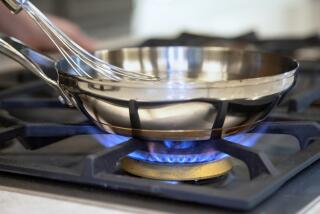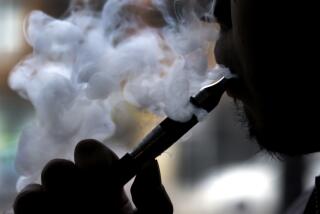Tobacco Firms Battle Flight Attendant Suit
- Share via
MIAMI — Tobacco companies have been uncharacteristically humble of late as they have sought a nationwide peace with their legal adversaries. But they are fighting back in their fabled hard-nosed style against a landmark class-action suit here that seeks damages for ailments supposedly caused by secondhand smoke.
The suit, now playing out in Dade County Circuit Court, contends that as many as 60,000 nonsmoking U.S. flight attendants have suffered illnesses such as bronchitis and cancer from working in smoky airline cabins prior to an in-flight smoking ban in 1989. The 6-year-old case, Broin vs. Philip Morris Cos., takes its name from Norma Broin, lead plaintiff and a lifelong nonsmoker who contracted lung cancer in 1989 after 13 years as a flight attendant.
After nearly two months of plaintiffs’ testimony, tobacco lawyers last week finally began their case, calling seven witnesses in an effort to convince jurors that airline tobacco smoke was so diluted that it could not possibly have harmed flight crews.
But the defense, which despite the case’s name includes all the tobacco companies, got off to a bumpy start. Agitated tobacco lawyers, complaining of judicial bias, sought to oust Judge Robert P. Kaye after he compared the industry’s role in smoking research to the fox guarding the henhouse.
During testimony Tuesday, Kaye barred industry witness Roger Jenkins, a chemist at Oak Ridge National Laboratory and co-author of a study on secondhand smoke, from discussing the research on grounds that R.J. Reynolds Tobacco Co.’s assistance with field work and lab analysis made it suspect.
In many instances, a judge would allow such testimony and leave it to plaintiffs to try to discredit the study in cross-examination. But Kaye, a stocky, white-maned former radio broadcaster, refused to let the evidence in.
“This trial reminds me of Alice in Wonderland,” Kaye remarked with jurors out of the courtroom. “Every day it gets curiouser and curiouser. . . . And maybe, succinctly put, it can be said that it reminds you of having the fox in the henhouse in a situation like that.”
Tobacco lawyers were outraged by the ruling and by Kaye’s refusal to allow testimony that other exposures, such as to cosmic radiation or ozone, could explain flight attendants’ health complaints.
In a motion filed Wednesday, which Kaye quickly denied, R.J. Reynolds’ lawyers called on the judge to recuse himself because he “harbors a presumption of inappropriate behavior against Reynolds and its counsel, and . . . intends to inappropriately restrict Reynolds from presenting its defense.”
Nonetheless, industry lawyers succeeded in getting in testimony that is basic to their case.
Michael Ogden, a chemist for R.J. Reynolds, testified that smoke concentrations in airline cabins were so diffuse that crews had breathed the equivalent of just two to three cigarettes per year.
The jury previously had heard a radically different estimate from a plaintiffs’ expert, who testified that flight attendants breathed the carcinogenic equivalent of up to a half-pack of cigarettes on each transcontinental flight.
During cross-examination, Ogden also took the industry’s standard position that even for active smoking, scientific proof of causation of disease has not been “adequately established.”
Christopher Coggins, senior vice president for science and technology at cigarette maker Lorillard Inc., also testified about his failed efforts to induce lung cancer in rats he had exposed to secondhand smoke while at a prior scientific post at R.J. Reynolds.
Despite the animals’ exposure to “very, very high concentrations of smoke” over long periods of time, “we did not see any response in the lungs whatsoever,” Coggins said. Based on animal studies and other research, Coggins said there is no scientific basis to conclude that secondhand smoke “at home or at work is even a risk factor for disease.”
Lawyers for the flight attendants have relied heavily on three reports by the National Academy of Sciences, the U.S. surgeon general and the Environmental Protection Agency, concluding that secondhand smoke is a significant cause of lung cancer in nonsmokers. Those reports were based largely on studies showing elevated rates of lung cancer among spouses of smokers who breathed secondhand smoke at home.
Reflecting the crucial role of these spousal studies, plaintiffs have been trying to show that airline cabins were smokier than the homes of cigarette smokers, while the industry has maintained that the opposite is true.
The industry’s lead-off witness, aviation expert Martin Godley, testified that the ventilation systems of jetliners turn over the air every few minutes, flushing out smoke and other contaminants, whereas a full exchange of air in a home can take hours.
But plaintiffs lawyer Stanley Rosenblatt hopes that what sticks in jurors’ minds are the large sums the industry paid for its witnesses’ expertise, which he brought out in cross-examination.
Godley acknowledged that tobacco companies have paid his consulting firm more than $300,000 for work on this case and other projects. And Jolanda Janczewski, a ventilation expert who also testified last week, said she and her firm, Consolidated Safety Services, had received more than $800,000 from tobacco companies in recent years.
Tobacco lawyers, however, are not only concerned with jurors’ reactions to testimony in court, they also fear that the jurors might see the highly publicized developments in the smoking wars as evidence of industry wrongdoing.
In late June, shortly after jury selection began in this case, negotiators unveiled the proposed giant tobacco peace accord between cigarette makers and 40 state attorneys general, in which tobacco companies agreed to pay $368.5 billion over 25 years. Then, because Congress had not ratified the deal, the industry in July and August reached highly publicized multibillion-dollar settlements with Mississippi and Florida to keep their massive lawsuits from going to trial. And President Clinton recently called on Congress to pass legislation implementing a tougher tobacco deal.
Judge Kaye repeatedly has admonished the jury to avoid news on the smoking wars, but it may be easier said than done.
A victory for the flight attendants could mean collective damages in the hundreds of millions--or even billions--of dollars, and could make the industry vulnerable to more passive-smoking claims.
Conversely, an industry win would eliminate the threat of mass claims by the flight attendants, who may have the best chance of winning a passive-smoking case.
Equally important, the case is one of several battles that will influence the tone and substance of congressional debate on legislation to implement the tobacco accord. Others include Texas’ Medicaid suit against the industry, set for trial next month, and an upcoming ruling by a federal appeals court on the Food and Drug Administration’s authority to regulate tobacco products.
Victories by the industry would strengthen its hand in congressional negotiations, while defeats would embolden anti-smoking groups and tobacco foes in Congress to raise the price of peace.
Defense testimony in the case is expected to continue well into next month, after which jurors will decide two questions: Does secondhand smoke cause lung cancer and other diseases? And did the industry commit fraud by concealing or misrepresenting the dangers?
If the answers are no, the companies win. If they are yes, a second phase will follow in which plaintiffs will try to prove that the specific ailments of flight attendants designated as representatives of the class action were caused by secondhand smoke.
More to Read
Inside the business of entertainment
The Wide Shot brings you news, analysis and insights on everything from streaming wars to production — and what it all means for the future.
You may occasionally receive promotional content from the Los Angeles Times.









